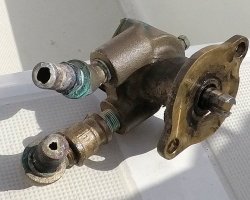We have a 1982 E38. Universal 3452 w/ 3,800 hours. We're cruising in Mexico. Water temps 75 degrees. At 1,700 RPM, engine will hold temp at 185 degrees (all temps measured with gun just top of thermostat). Rev. up to 2,100 and over a 5 to 8 minute period it climbs to ~210. Throttle back to 1,700 and she comes back down to 185. Operating temp. of engine is 175 to 190 degrees. I checking intake at hull and it's clear. Cleaned sea strainer. The impeller looks ok, although it's about 500 hours old. Removed end caps of Heat Exchanger and they were clear. Replace zinc anode and made sure there were no broken pieces. Water is exiting boat in what sounds a normal fashion. Shot at mixing elbow with gun and temp. 130. Just a few inches down towards the water lift muffler it's down to 115.
Next step will be to replace the impeller, then have the exchanger cleaned and check out the mixing elbow. Any other thoughts?
Does anyone know the typical volume of water that should be expelling? Looking for any ideas. Thanks.
Next step will be to replace the impeller, then have the exchanger cleaned and check out the mixing elbow. Any other thoughts?
Does anyone know the typical volume of water that should be expelling? Looking for any ideas. Thanks.
Last edited:

